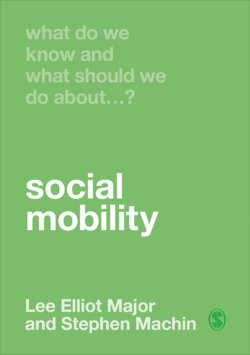What Do We Know and What Should We Do About Social Mobility?

Реклама. ООО «ЛитРес», ИНН: 7719571260.
Оглавление
Lee Elliot Major. What Do We Know and What Should We Do About Social Mobility?
What do we know and what should we do about…
Contents
Titles in the Series
About the Series
About the Authors
1 Introduction
Measures of Mobility
Social Mobility Research
Different Dimensions
Notes
2 Background
The Golden Age (1950–70)
Decade of Economic Decline (1970–80)
Ages of Growing Divides (1980–2008, 2008–20)
Rising Inequality (1980–2008)
The Era of Falling Absolute Mobility (2008–20)
Notes
3 What do We Know?
International
Anglophone comparisons
The Great Gatsby Curve
Absolute Comparisons
Decline. Millennial gloom
Fissuring of the workplace
Opportunity hoarding
Workplace Divides
Place. The place not to be
The US mobility map
London
Dynasty. A universal law?
Notes
4 What should we do? Fairness
Fair game? To whom?
Rawls’ test of fairness and justice
Questions of fairness
Collectivism
Inequality
Taxation
Collective action
Decency. Job parity policies
Human capital tax credits and a lifelong learning levy
Educational justice
A decent education for all
Levelling up
Community – Restoring local opportunities. The price of educational justice
Place-based approaches
Economic regeneration
Access. Merit wars
University admissions
Random justice
School lotteries
Private schools
Elite professions
Notes
Conclusion
References
Index
Отрывок из книги
Social Mobility?
Titles in the series
.....
Table 1.1
For the first three correlational measures, a value of 1 corresponds to complete immobility, with parents and offspring outcomes perfectly correlated. A correlation of 0 corresponds to complete mobility, with no relationship between family background and the adult outcomes of children. For transitions, the example given in the table splits parental and child measures into five equally sized groups – quintiles running from the bottom 20 per cent to the top 20 per cent. In this case, complete mobility corresponds to children growing up in any parental quintile having a 20 per cent chance of ending up in any of the five quintiles in their own generation. Complete immobility is where everyone stays in the same quintile as their parents. There is no movement and everyone remains on the diagonal of the five-by-five transition matrix.
.....